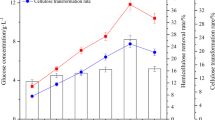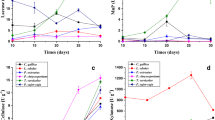Abstract
Itaconic acid production using lignocellulose materials is a promising approach to replace sugar substrates such as glucose that are expensive. However, the complicated detoxification of the hydrolysate is pre-requisite to remove the lignocellulose-derived inhibitors to enable high organic acid fermentation. In this study, the hydrolysate prepared using dry acid pretreated and biodetoxified corn stover was tested for itaconic acid production by the fungal strain Aspergillus terreus M69. Corn stover hydrolysate containing 0.85 g/L acetic acid severely inhibited the organic acid production, but a treatment on the hydrolysate with activated charcoal to remove partial acetic acid helped to produce 33.6 g/L itaconic acid at a yield of 0.56 g/g. Most acetic acid released during enzymatic hydrolysis other than pretreatment was responsible for the inhibition of itaconic acid production. The technol-economic analysis showed that the minimum itaconic acid selling price was $1.647 per kg, which was lower than its market price. This study demonstrates the great potential of itaconic acid production using lignocellulose.




Similar content being viewed by others
References
Werpy T, Petersen G (2004) Top value added chemicals from biomass. Volume I: results of screening for potential candidates from sugars and synthesis gas. https://www.nrel.gov/docs/fy04osti/35523.pdf. Accessed Aug 2014
Bafana R, Pandey RA (2018) New approaches for itaconic acid production: bottlenecks and possible remedies. Crit Rev Biotechnol 38:68–82
Okabe M, Lies D, Kanamasa S, Park EY (2009) Biotechnological production of itaconic acid and its biosynthesis in Aspergillus terreus. Appl Microbiol Biotechnol 84:597–606
Tippkotter N, Duwe AM, Wiesen S, Sieker T, Ulber R (2014) Enzymatic hydrolysis of beech wood lignocellulose at high solid contents and its utilization as substrate for the production of biobutanol and dicarboxylic acids. Bioresour Technol 167:447–455
Jiménez-Quero A, Pollet E, Zhao M, Marchioni E, Avérous L, Phalip V (2016) Itaconic and fumaric acid production from biomass hydrolysates by Aspergillus strains. J Microbiol Biotechnol 26:1557–1565
Li X, Zheng K, Lai CH, Ouyang J, Yong Q (2016) Improved itaconic accid production from undetoxified enzymatic hydrolysate of steam-exploded corn Stover using an Aspergillus terreus mutant generated by atmospheric and room temperature plasma. BioResources 11:9047–9058
Pedroso GB, Montipó S, Mario DAN, Alves SH, Martins AF (2017) Building block itaconic acid from left-over biomass. Biomass Convers Bioref 7:23–25
Krull S, Eidt L, Hevekerl A, Kuenz A, Prüße U (2017) Itaconic acid production from wheat chaff by Aspergillus terreus. Process Biochem 63:169–176
He Y, Zhang J, Bao J (2016) Acceleration of biodetoxification on dilute acid pretreated lignocellulose feedstock by aeration and the consequent ethanol fermentation evaluation. Biotechnol Biofuels 9:19
Qureshi AS, Zhang J, Sousa LD, Bao J (2017) An antibacterial peptide secreted by Pediococcus acidilactici enables efficient cellulosic open L-lactic acid fermentation. ACS Sustain Chem Eng 9:9254–9262
Zhang J, Zhu ZN, Wang X, Wang W, Bao J (2010) Biodetoxification of toxins generated from lignocellulose pretreatment using a newly isolated fungus Amorphotheca resinae ZN1 and the consequent ethanol fermentation. Biotechnol Biofuels 3:26
Zhang J, Wang X, Chu D, He Y, Bao J (2011) Dry pretreatment of lignocellulose with extremely low steam and water usage for bioethanol production. Bioresour Technol 102:4480–4488
Qiu Z, Gao Q, Bao J (2018) Engineering Pediococcus acidilactici with xylose assimilation pathway for high titer cellulosic L-lactic acid fermentation. Bioresour Technol 249:9–15
Wei C, Liu G, Zhang J, Bao J (2018) Elevating fermentation yield of cellulosic lactic acid in calcium lactate form from corn Stover feedstock. Ind Crop Prod 126:415–420
Liu G, Zhang Q, Li HX, Qureshi A, Zhang J, Bao X, Bao J (2018) Dry biorefining maximized the potentials of simultaneous saccharification and co-fermentation for cellulosic ethanol production. Biotechnol Bioeng 115:60–69
Sluiter A, Hames B, Ruiz R, Scarlat C, Sluiter J, Templeton D, Crocker D (2012) Determination of structural carbohydrates and lignin in biomass. Technical Report NREL/TP-510-42618. Laboratory Analytical Procedure (LAP), Golden
Adney B, Baker J (1996) Measurement of cellulase activities. LAP-006, NREL analytical procedure. National Renewable Energy Laboratory, Golden
Ghose T (1987) Measurement of cellulase activities. Pure Appl Chem 59:257–268
Bradford M (1976) A rapid and sensitive method for the quantitation of microgram quantities of protein utilizing the principle of protein-dye binding. Anal Biochem 25:248–256
He Y, Zhang L, Zhang J, Bao J (2014) Helically agitated mixing in dry dilute acid pretreatment enhances the bioconversion of corn Stover into ethanol. Biotechnol Biofuels 7(1):1
Schirmer-Michel A, Flores S, Hertz P, Matos G, Ayub M (2008) Production of ethanol from soybean hull hydrolysate by osmotolerant Candida guilliermondii NRRL Y-2075. Bioresour Technol 99:2898–2904
Rychtera M, Wase DAJ (1981) The growth of Aspergillus terreus and the production of itaconic acid in batch and continuous cultures, the influence of pH. J Chem Technol Biotechnol 31:509–521
Riscaldati E, Moresi M, Federici F, Petruccioli M (2000) Effect of pH and stirring rate on itaconate production by Aspergillus terreus. J Biotechnol 83:219–230
Hu M, Wang J, Gao Q, Bao J (2018) Converting lignin derived phenolic aldehydes into microbial lipid by Trichosporon cutaneum. J Biotechnol 281:81–86
Humbird D, Davis R, Tao L, Kinchin C, Hsu D, Aden A, Schoen P, Lukas J, Olthof B, Worley M, Sexton D, Dudgeon D (2011) Process design and economics for biochemical conversion of lignocellulosic biomass to ethanol. Report NREL/TP-5100-47764
Hodge D, Andersson C, Berglund K, Rova U (2009) Detoxification requirements for bioconversion of softwood dilute acid hydrolyzates to succinic acid. Enzym Microb Technol 44:309–316
Magalhães AI, de Carvalho JC, Medina JDC, Soccol CR (2017) Downstream process development in biotechnological itaconic acid manufacturing. Appl Microbiol Biotechnol 101:1–12
Nieder-Heitmann M, Haigh KF, Gorgens JF (2018) Process design and economic analysis of a biorefinery co-producing itaconic acid and electricity from sugarcane bagasse and trash lignocelluloses. Bioresour Technol 262:159–168
Liu G, Sun J, Zhang J, Tu Y, Bao J (2015) High titer L-lactic acid production from corn Stover with minimum wastewater generation and techno-economic evaluation based on Aspen plus modeling. Bioresour Technol 198:803–810
Saha BC, Kennedy GJ, Bowman MJ, Qureshi N, Dunn RO (2018) Factors affecting production of itaconic acid from mixed sugars by Aspergillus terreus. Appl Biochem Biotechnol 187:449–460. https://doi.org/10.1007/s12010-018-2831-2
Yi X, Gu H, Gao Q, Liu Z, Bao J (2015) Transcriptome analysis of Zymomonas mobilis ZM4 reveals mechanisms of tolerance and detoxification of phenolic aldehyde inhibitors from lignocellulose pretreatment. Biotechnol Biofuels 8:153
Yi X, Zhang P, Sun J, Tu Y, Gao Q, Zhang J, Bao J (2016) Engineering wildtype robust Pediococcus acidilactici strain for high titer L- and D-lactic acid production from corn Stover feedstock. J Biotechnol 217:112–121
Pampulha ME, Loureirodias MC (1989) Combined effect of acetic acid, pH and ethanol on intracellular pH of fermenting yeast. Appl Microbiol Biotechnol 31:547–550
Kuenz A, Krull S (2018) Biotechnological production of itaconic acid-things you have to know. Appl Microbiol Biotechnol 102:3901–3914
Chen X, Kuhn E, Jennings E, Nelson R, Tao L, Zhang M, Tucker M (2016) DMR (deacetylation and mechanical refining) processing of corn Stover achieves high monomeric sugar concentrations (230 g L-1) during enzymatic hydrolysis and high ethanol concentrations (>10% v/v) during fermentation without hydrolysate purification or concentration. Energy Environ Sci 9:1237–1245
Funding
This research was supported by the Natural Science Foundation of China (3181101658), the National Key Research and Development Program of China (2017YFB0309302), the Shanghai Pujiang Program (18PJD013), the Shanghai Sailing Program (19YF1410700), the China Postdoctoral Science Foundation (2018 M632043), the Fundamental Research Funds for the Central Universities of China (WF1814033), and the Open Funding Project of the Key Laboratory of Development and Application of Rural Renewable Energy. V.B. received startup funds from the University of Houston and the State of Texas.
Author information
Authors and Affiliations
Corresponding author
Additional information
Publisher’s note
Springer Nature remains neutral with regard to jurisdictional claims in published maps and institutional affiliations.
Electronic supplementary material
ESM 1
(DOCX 23 kb)
Rights and permissions
About this article
Cite this article
Liu, Y., Liu, G., Zhang, J. et al. Itaconic acid fermentation using activated charcoal-treated corn stover hydrolysate and process evaluation based on Aspen plus model. Biomass Conv. Bioref. 10, 463–470 (2020). https://doi.org/10.1007/s13399-019-00423-3
Received:
Revised:
Accepted:
Published:
Issue Date:
DOI: https://doi.org/10.1007/s13399-019-00423-3




